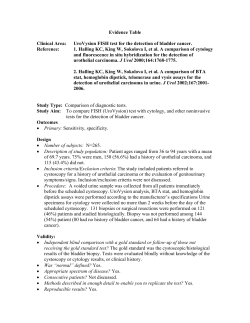
Bladder Tumor Antigen Stat Test in Non-Urothelial Malignant Urologic Conditions
Original Articles Bladder Tumor Antigen Stat Test in Non-Urothelial Malignant Urologic Conditions Moshe Wald MD1, Sarel Halachmi MD1, Gilad Amiel MD1, Shahar Madjar MD1, Michael Mullerad MD1, 2 1 1 Ines Miselevitz MD , Boaz Moskovitz MD and Ofer Nativ MD 1 Department of Urology and 2Department of Pathology, Bnai Zion Medical Center, Haifa, Israel Key words: bladder tumor antigen, urine cytology, non-urothelial malignant urologic conditions Abstract The bladder tumor antigen stat is a simple and fast one-step immunochromatographic assay for the detection of bladder tumor-associated antigen in urine. To evaluate the BTA stat in non-bladder cancer patients in order to identify the categories contributing to its low specificity. A single voided urine sample was collected from 45 patients treated in the urology clinic for conditions not related to bladder cancer. Each urine sample was examined by the BTA stat test and cytology. The overall specificity of the BTA stat test was 44%, which was significantly lower than that of urine cytology, 90%. The false positive rates for the BTA stat test varied among the different clinical categories, being highest in cases of urinary tract calculi (90%), and benign prostatic hypertrophy (73%). Exclusion of these categories from data analysis improved BTA stat specificity to 66%. Clinical categories contributing to low BTA stat specificity can be identified, and their exclusion improves the specificity of this test. Background: Objectives: The aim of the present study was to evaluate BTA stat test results for those non-urothelial cancer cases in order to identify possible clinical categories whose exclusion will enable improved specificity of the BTA stat test. Patients and Methods The study was conducted in the Bnai Zion Medical Center, Haifa, Israel, between April 1997 and September 1999. Eligible for participation were patients without a history of bladder cancer. Patients in whom bladder cancer was diagnosed during the investigation were excluded. The study included 45 patients treated in the urology clinic for urinary tract calculi (n=10), renal cell carcinoma (n=9) prostatic carcinoma (n=5), urinary tract infection (n=3), benign prostatic hypertrophy (n=11), stress urinary incontinence (n=4), hematuria of unknown origin (n=2), and indwelling urinary catheter (n=1). Males comprised 71% of the population and females 29%. All subjects provided a single midstream or catheterized urine IMAJ 2002;4:174±175 sample prior to cystoscopy. A portion of the sample was processed according to the instructions provided in the BTA stat test kit, and the remaining urine was sent for cytologic examination. This was Early diagnosis of bladder cancer allows the possibility of less done according to standard procedures, with the performer blinded invasive surgical treatment and higher 5 year survival rates for to the BTA test results. Cystoscopy was performed only when superficial tumors [1,2]. Cystoscopy is considered to be the golden justified by the clinical circumstances. The BTA stat test is performed by placing five drops of fresh standard for the diagnosis of bladder cancer. The diagnostic workup usually includes voided or wash-urine cytology. However, urine untreated urine in the well of the disposable kit. Mixing with cytology carries some disadvantages: it is examiner-dependent, it antibody in the well, the urine passes to the test zone that contains has a relatively low sensitivity for low grade bladder tumors [3], it is fixed capture antibodies. In the presence of bladder tumortime consuming, and its results are not available immediately. To associated antigen, a visible line appears in the test zone. Any circumvent these pitfalls, several urinary tumor markers were intensity of this line indicates a positive test. If no antigen is devised, and were found to be simple, objective and sensitive present, no line appears. The control zone of the kit contains a fixed reagent that combines with the antibody to form a visible line alternatives to urine cytology [4±7]. The bladder tumor antigen stat test, performed in a disposable unrelated to the presence of bladder tumor-associated antigen in kit, detects bladder tumor-associated antigen within 5 minutes of the urine. Therefore, appearance of a line in the control zone of the placing fresh untreated urine in the well. The antigen detected ± kit indicates its correct usage. The results are read within 5 minutes human complement factor-4-related protein ± was found in vitro to of placing urine in the well. be produced by human bladder cancer but not by non-cancerous Specificity was calculated overall and within each clinical cell lines [8]. The BTA stat test was reported to have higher category. False positive rate was calculated for each category by sensitivity but lower specificity when compared with urine cytology dividing the number of false positives (a) by the sum of false [4]. The low specificity of the BTA stat test was suggested to be positives (a) and true negatives (b) (false positive rate =a/a+b). related to certain urinary tract pathologic conditions not associated Results with urothelial cancer. The overall and differential results for the BTA stat test, voided urine cytology and cystocopy are presented in Tables 1 and 2. The BTA = bladder tumor antigen Methods: Results: Conclusions: 174 M. Wald et al. IMAJ . Vol 4 . March 2002 Original Articles Overall results of the BTA stat test and cystoscopy hypertrophy group (73%). BPH, as a separate group, was not previously found to interfere Patient group No. of Positive BTA BTA stat Cystoscopy with the BTA stat test. The false positive rate patients stat test false positive in the renal and prostate cancer groups was rate (%) Positive Negative similar (22% and 20%, respectively), suggestUrinary tract calculi 10 9 90 ± 7 ing possible unification of these groups into Renal cell carcinoma 9 2 22 ± 2 Prostatic carcinoma 5 1 20 ± 3 one ± titled non-urothelial malignancies. The Urinary tract infection 3 1 33 ± 2 heterogenicity of such a group may lead to Benign prostatic hypertrophy 11 8 73 ± 11 different results, such as BTA stat test Hematuria of unknown origin 2 1 50 ± 2 specificity of only 17% for tumors other than Stress urinary incontinence 4 2 50 ± 1 bladder cancer [4]. The presence of mRNA for Indwelling urinary catheter 1 1 100 ± 1 human complement factor-H-related proteins Total 45 25 0 29 in cultured prostate and renal carcinoma cell lines [4] may possibly explain the false Differential specificity for voided urine cytology positive BTA stat results in these patients. Due to the small size of the other clinical categories, we believe Patient group Voided urine that, at this point, conclusions should be drawn only regarding cytology those categories discussed above. Nevertheless, it seems that the specificity (%) first two categories, urinary tract calculi and BPH, which exhibited Urinary tract calculi 100 high false positive rates, should be considered as exclusion criteria Renal cell carcinoma 100 for the clinical usage of the BTA stat test, while the moderate false Prostatic carcinoma 75 Urinary tract infection 100 positive rates of the non-urothelial malignancies permit this Benign prostatic hypertrophy 87.5 category to remain as a relative exclusion criterion. This is Hematuria of unknown origin 100 emphasized by eliminating urinary tract calculi and BPH from the Stress urinary incontinence ± data analysis, whereby the specificity of BTA stat test improved from Indwelling urinary catheter 0 44% to 66%. In conclusion, clinical categories contributing to the Total 90.5 low specificity of BTA stat test can be identified, and their exclusion from data analysis leads to improvement of the BTA stat test's specificity. BTA stat test was found to be negative in only 20 of the 45 cases evaluated, yielding a specificity of 44%. This value was lower than References the specificity value for urine cytology, calculated to be as high as 1. Cheng L, Neuman RM, Weaver AL, et al. Predicting cancer progression in patients with stage T1 bladder carcinoma. J Clin Oncol 1999;17:3182±7. 90%. de La Muela P, Rosell D, Aguera L, et al. Multivariate analysis of The BTA stat test false positive rates for the different categories 2. Sanchez progression in superficial bladder cancer. Br J Urol 1993;71:284±9. were: urinary tract calculi 90%, renal cell carcinoma 22%, prostatic 3. Ozols RF. Management of bladder cancer. Curr Probl Cancer 1995;19:4± cancer 20%, urinary tract infection 33%, benign prostatic hyper63. trophy 73%, hematuria of unknown origin 50%, stress urinary 4. Leyh H, Marberger M, Conort P, et al. Comparison of the BTA stat test with voided urine cytology and bladder wash cytology in the diagnosis incontinence 50%, and indwelling urinary catheter 100%. Table 1. Table 2. Discussion While several possible markers for urinary bladder cancer are still under investigation [4±7], the clinical usage of the BTA stat test as such a marker was already evaluated in several studies [4,9]. Most authors report an advantage of the BTA stat test over voided urine cytology in terms of sensitivity, yet the specificity of the BTA stat test is consistently described as lower. In order to identify factors contributing to this low specificity of the BTA stat test, a heterogeneous population of non-bladder cancer patients was investigated. Stratification according to the urologic disturbance revealed differential false positive rates. The highest false positive rate was recorded among patients with urinary tract calculi (90%), followed by the benign prostatic BPH = benign prostatic hypertrophy IMAJ . Vol 4 . March 2002 and monitoring of bladder cancer. Eur Urol 1999;35:52±6. 5. Fradet Y, Cordon-Cardo C. Critical appraisal of tumor markers in bladder cancer. Semin Urol 1993;11:145±53. 6. Rozanski TA, Grossman HB. Recent developments in the pathophysiology of bladder cancer. AJR 1994;163:789±92. 7. Lokeshwar VB, Obek C, Soloway MS, et al. Tumor associated hyaluronic acid: a new sensitive and specific urine marker for bladder cancer. Cancer Res 1997;57:773±7. 8. Kinders R, Root R, Jones T, et al. Complement factor H-related proteins are expressed in bladder cancers. AACR: Proceedings of the 88th Annual Meeting, San Diego, USA. Cancer Res 1997;38:29, Abstract No. 189. 9. Sarosdy MF, Hudson MA, Ellis WJ, et al. Improved detection of recurrent bladder cancer using the BTA stat test. Urology 1997;50:349±53. Correspondence: Dr. M. Wald, Dept. of Urology, Bnai Zion Medical Center, 47 Golomb St., Haifa 33394, Israel. Phone: (972-4) 835-9523 Fax: (972-4) 835-9524 email: moshewald@hotmail.com BTA Stat to Detect Urologic Tumor 175
© Copyright 2025





















